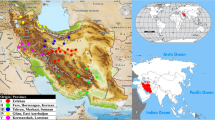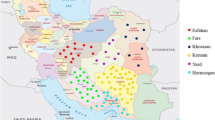Abstract
Dendrobium officinale K. Kimura et Migo is an endangered and valuable medicinal herb. In order to understand the origin of D. officinale cultivars and the differences in germplasm resources, 81 D. officinale individuals including wild-collected, market-collected, and two germplasm resources from Zhejiang and Jiangxi province was scanned with 75 EST-SSRs. The number of alleles detected at each locus ranged from 1 to 14 with an average of 3.703. The mean expected heterozygosity (0.492), and Shannon’s information index (0.915) indicated a high level of hybridization rate among the individuals tested. Principal component analysis and cluster analysis based on UPGMA illustrated that almost all the germplasm resources from Jiangxi were grouped together, then the germplasm resources from Zhejiang, wild-collected and market-collected were divided into three clusters, indicated that the origin of market-collected individuals were derived from Zhejiang and the germplasm resources from Jiangxi were well preserved and waited for development. Eight recovered sequences of fructose-bisphosphate aldolase 1 from wild-collected and two germplasm resources showed that the similarity of these sequences ranged from 71.15 to 93.42%, and base insertion, deletion and base varieties occurred in almost all the 7 recovered sequences. On the basis of EST-SSR analysis and keeping in view the purity and stability, the D. officinale germplasm resources from Jiangxi was recommended for hybridization in order to develop superior cultivars.




Similar content being viewed by others
References
Bagchi S, Kumar KJ (2016) Studies on water soluble polysaccharides from Pithecellobium dulce (Roxb.) Benth seeds. Carbohydr Polym 138:215–221
Borba EL, Felix JM, Solferini VN, Semir J (2001) Fly-pollinated Pleurothallis (Orchidaceae) species have high genetic variability: evidence from isozyme markers. Am J Bot 88(3):419–428
Coelho NHP, Tambarussi EV, Aguiar BI, Roque RH, Portela RM, Braga RC, Kageyama PY (2018) Understanding genetic diversity, spatial genetic structure, and mating system through microsatellite markers for the conservation and sustainable use of Acrocomia aculeata (Jacq.) Lodd. Ex Mart. Conserv Genet 19(4):879–891
Feng S, Jiao K, Guo H, Jiang M, Hao J, Wang H, Shen C (2017) Succinyl-proteome profiling of Dendrobium officinale, an important traditional Chinese orchid herb, revealed involvement of succinylation in the glycolysis pathway. BMC Genom 18(1):598
Fu LK, Jin JM (1992) China plant red data book—rare and endangered plants, vol 1. Science Press, Beijing
Fu T, Hu ZY, He YQ (2017) Development of EST-SSR molecular markers in Dendrobium officinale. J Nucl Agric Sci 31(4):0663–0670
Gómez OJ, Blair MW, Frankow-Lindberg BE, Gullberg U (2005) Comparative study of common bean (Phaseolus vulgaris L) landraces conserved ex situ in genebanks and in situ by farmers. Genet Resour Crop Evol 52(4):371–380
Gu S, Ding XY, Wang Y, Zhou Q, Ding G, Li XX, Qian L (2007) Isolation and characterization of microsatellite markers in Dendrobium officinale, an endangered herb endemic to China. Mol Ecol Notes 7(6):1166–1168
Hadj-Arab H, Chèvre AM, Gaude T, Chable V (2010) Variability of the self-incompatibility reaction in Brassica oleracea L. with S 15 haplotype. Sex Plant Reprod 23(2):141–151
Hou B, Tian M, Luo J, Ji Y, Xue Q, Ding X (2012) Genetic diversity assessment and ex situ conservation strategy of the endangered Dendrobium officinale (Orchidaceae) using new trinucleotide microsatellite markers. Plant Syst Evol 298(8):1483–1491
Huang K, Li Y, Tao S, Wei G, Huang Y, Chen D, Wu C (2016) Purification, characterization and biological activity of polysaccharides from Dendrobium officinale. Molecules 21(6):701
Huda MK, Wilcock CC (2008) Impact of floral traits on the reproductive success of epiphytic and terrestrial tropical orchids. Oecologia 154(4):731–741
Khodaeiaminjan M, Kafkas S, Motalebipour EZ, Coban N (2018) In silico polymorphic novel SSR marker development and the first SSR-based genetic linkage map in pistachio. Tree Genet Genom 14(4):45
Li X, Ding X, Chu B, Zhou Q, Ding G, Gu S (2008) Genetic diversity analysis and conservation of the endangered Chinese endemic herb Dendrobium officinale Kimura et Migo (Orchidaceae) based on AFLP. Genetica 133(2):159–166
Li Q, Mo J, Wu W, Yang J, Li J, Lai T, Liao J (2019) Genetic diversity, population structure and identification of Dendrobium cultivars with high polysaccharide contents using SCoT, SCAR and nested PCR markers. Genet Resour Crop Evol 66(1):71–88
Liu J, He T, Chun Z (2009) DNA molecular identification of Herba Dendrobium and its adulterant species based on ITS sequence analysis. Zhongguo Zhong yao za zhi 34(22):2853–2856
Lu JJ, Suo NN, Hu X, Wang S, Liu JJ, Wang HZ (2012) Development and characterization of 110 novel EST-SSR markers for Dendrobium officinale (Orchidaceae). Am J Bot 99(10):415–420
Negri V, Tiranti B (2010) Effectiveness of in situ and ex situ conservation of crop diversity. What a Phaseolus vulgaris L. landrace case study can tell us. Genetica 138(9–10):985–998
Nei M (1978) Estimation of average heterozygosity and genetic distance from a small number of individuals. Genetics 89(3):583–590
Ng TB, Liu J, Wong JH, Ye X, Sze SCW, Tong Y, Zhang KY (2012) Review of research on Dendrobium, a prized folk medicine. Appl Microbiol Biotechnol 93(5):1795–1803
Nichol ST, Rowe JE, Winton JR (1995) Molecular epizootiology and evolution of the glycoprotein and non-virion protein genes of infectious hematopoietic necrosis virus, a fish rhabdovirus. Virus Res 38(2–3):159–173
Pan LH, Li XF, Wang MN, Zha XQ, Yang XF, Liu ZJ, Luo JP (2014) Comparison of hypoglycemic and antioxidative effects of polysaccharides from four different Dendrobium species. Int J Biol Macromol 64:420–427
Parthiban S, Govindaraj P, Senthilkumar S (2018) Comparison of relative efficiency of genomic SSR and EST-SSR markers in estimating genetic diversity in sugarcane. 3 Biotech 8(3):144
Peakall ROD, Smouse PE (2006) GENALEX 6: genetic analysis in Excel. Population genetic software for teaching and research. Mol Ecol Notes 6(1):288–295
Qian ZZ, Yang D, Yan ZL, Yong PENG (2010) Pharmacopoeia of the People’s Republic of China (2010 edition): a milestone in development of China’s healthcare. Chin Herb Med 2(2):157–160
Rucińska A, Puchalski J (2011) Comparative molecular studies on the genetic diversity of an ex situ garden collection and its source population of the critically endangered polish endemic plant Cochlearia polonica E. Fröhlich Biodivers Conserv 20(2):401–413
Sahoo A, Jena S, Kar B, Sahoo S, Ray A, Singh S, Nayak S (2017) EST-SSR marker revealed effective over biochemical and morphological scepticism towards identification of specific turmeric (Curcuma longa L.) cultivars. 3 Biotech 7(1):84
Shapturenko MN, Pechkovskaya TV, Vakula SI, Jakimovich AV, Zabara YM, Khotyleva LV (2017) Informative EST-SSR markers for genotyping and intraspecific differentiation of Brassica oleracea var. capitata L. Russ J Genet Appl Res 7(1):14–20
Shiau YJ, Nalawade SM, Hsia CN, Mulabagal V, Tsay HS (2005) In vitro propagation of the Chinese medicinal plant, Dendrobium candidum Wall. Ex Lindl., from axenic nodal segments. In Vitro Cell Dev Biol Plant 41(5):666–670
Slater AT, Calder DM (1988) The pollination biology of Dendrobium speciosum Smith: a case of false advertising? Aust J Bot 36(2):145–158
Vos P, Hogers R, Bleeker M, Reijans M, Lee TVD, Hornes M, Zabeau M (1995) AFLP: a new technique for DNA fingerprinting. Nucl Acids Res 23(21):4407–4414
Wan RL, Sun J, He T, Hu YD, Zhao Y, Wu Y, Chun Z (2017) Cloning cDNA and functional characterization of UDP-glucose pyrophosphorylase in Dendrobium officinale. Biol Plant 61(1):147–154
Wang XJ, Yu L, Yin SH (2009) Pollintion modes effects on fruit set and seed viability of Dendrobium fimbriatum (Orchidaceae). J Yunnan Univ (Nat Sci Ed) S1
Wu Y, Si J (2010) Present status and sustainable development of Dendrobium of ficinale industry. China J Chin Mater Med 15
Xie Y, Sung W (2007) Conservation status of Chinese species: (1) overview. Integr Zool 2(1):26–35
Xie M, Hou B, Han L, Ma Y, Ding X (2010) Development of microsatellites of Dendrobium officinale and its application in purity identification of germplasm. Acta Pharm Sin 45(5):667–672
Xing S, Zhang X, Ke H, Lin J, Huang Y, Wei G (2018) Physicochemical properties of polysaccharides from Dendrobium officinale by fractional precipitation and their preliminary antioxidant and anti-HepG2 cells activities in vitro. Chem Central J 12(1):100
Yang S, Gong Q, Wu Q, Li F, Lu Y, Shi J (2014) Alkaloids enriched extract from Dendrobium nobile Lindl. attenuates tau protein hyperphosphorylation and apoptosis induced by lipopolysaccharide in rat brain. Phytomedicine 21(5):712–716
Yang J, Wu H, Lv CG, Wang S, Zhang XB, Yang G, Huang LQ (2018) Geographical origin discriminant of Dendrobium officinale based on stable isotope ratios. China J Chin Mater Med 43(6):1118–1123
Zha XQ, Luo JP, Wei P (2009) Identification and classification of Dendrobium candidum species by fingerprint technology with capillary electrophoresis. South Afr J Bot 75(2):276–282
Zhang YJ, Song J, Cheng XJ (2018) The complete chloroplast genome sequence of an endangered traditional Chinese medicine plant Dendrobium candidum (Orchidaceae). Conserv Genet Resour 10(1):9–11
Zheng SG, Hu YD, Zhao RX, Yan S, Zhang XQ, Zhao TM, Chun Z (2018) Genome-wide researches and applications on Dendrobium. Planta 248(4):769–784
Acknowledgements
The work was supported by Major projects of key research programs in Jiangxi province (Grant No. 20171ACF60017; 20192ACB60013) and Education Department Project in Jiangxi Province (Grant No. GJJ170196).
Author information
Authors and Affiliations
Corresponding author
Ethics declarations
Conflict of interest
The authors declare that they have no conflict of interest.
Additional information
Publisher's Note
Springer Nature remains neutral with regard to jurisdictional claims in published maps and institutional affiliations.
Electronic supplementary material
Below is the link to the electronic supplementary material.
Rights and permissions
About this article
Cite this article
Xie, J., Zuo, J., Huang, Y. et al. The origin and germplasm collection for cultivated Dendrobium officinale K. Kimura & Migo individuals revealed by EST-SSR markers. Genet Resour Crop Evol 67, 1209–1219 (2020). https://doi.org/10.1007/s10722-020-00906-7
Received:
Accepted:
Published:
Issue Date:
DOI: https://doi.org/10.1007/s10722-020-00906-7




